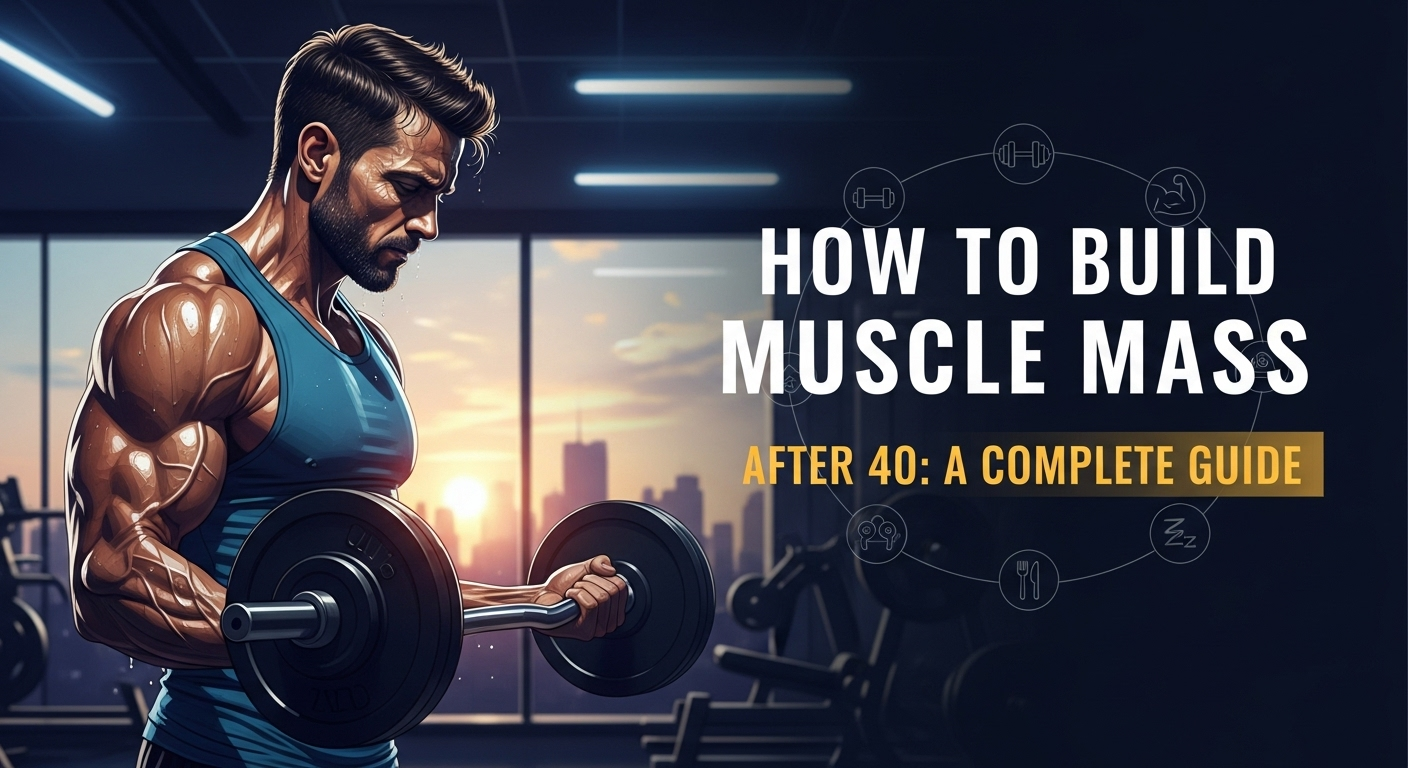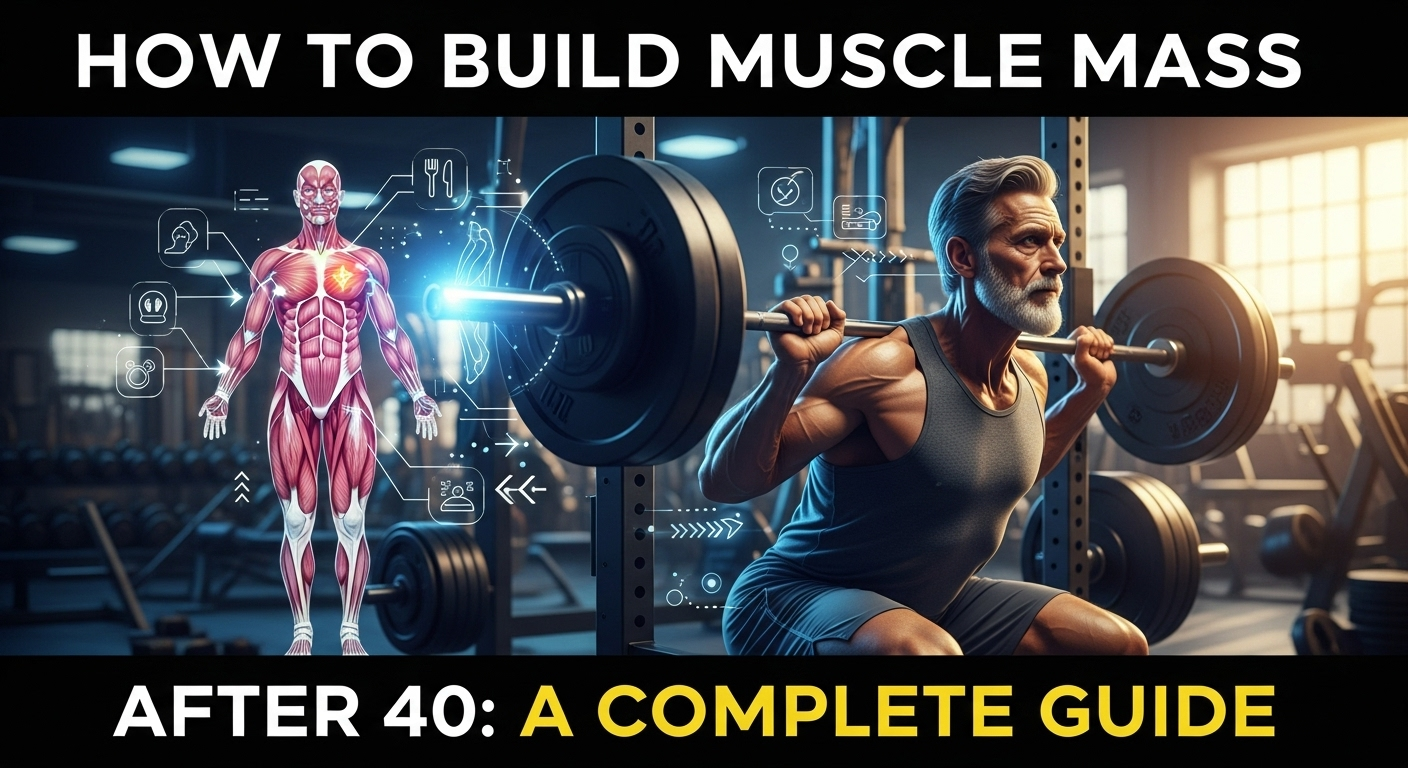Hitting your 40s often comes with a new perspective on health and fitness. The carefree metabolism of your 20s may feel like a distant memory, and you might notice that maintaining, let alone building, muscle is becoming a tougher challenge. You're not imagining it. Biological changes, including hormonal shifts and a natural decline in muscle synthesis, make the process different. However, the idea that your best physical years are behind you is a myth. The key to success lies in a smarter, more strategic approach. This comprehensive guide will show you exactly how to build muscle mass after 40, proving that age is truly just a number when armed with the right knowledge and dedication.
Table of Contents
ToggleUnderstanding the "Over 40" Challenge: Sarcopenia and Hormonal Shifts
Before diving into the "how," it's crucial to understand the "why." Why does building muscle feel different after 40? The primary culprit is a process called sarcopenia, the age-related involuntary loss of muscle mass, strength, and function. This process can begin as early as your 30s and accelerates with each passing decade if left unchecked. It's a natural part of aging, but "natural" does not mean it's uncontrollable. Resistance training is the single most effective antidote to sarcopenia, sending a powerful signal to your body to preserve and build new muscle tissue.
Hormonal changes also play a significant role. For men, testosterone levels, a key hormone for muscle protein synthesis, begin a slow and steady decline. For women, the approach of perimenopause and menopause brings fluctuations and an eventual drop in estrogen and progesterone. These hormones do more than just regulate reproductive health; they also influence muscle repair, bone density, and fat distribution. A decrease in these hormones can make it harder to recover from workouts and easier to store fat, creating a more challenging environment for muscle growth.
However, this is not a doomsday scenario. It’s simply a change in the rules of the game. Your body is still incredibly capable of adapting and growing stronger. Understanding these biological shifts allows you to work with your body, not against it. It means your training, nutrition, and recovery must be more intentional and precise than ever before. With a strategic plan, you can effectively counteract these changes and build a stronger, more resilient physique than you had in your younger years.
The Foundation: Progressive Overload and Strategic Strength Training
If there is a single, non-negotiable principle for building muscle at any age, it is progressive overload. This principle states that for a muscle to grow, it must be forced to adapt to a tension that is above and beyond what it has previously experienced. After 40, this principle becomes even more critical. Your body requires a clear and consistent signal that muscle is not a "luxury" it can afford to lose but a "necessity" it must build to meet the demands you place on it. Without progressive overload, your workouts are simply exercise, not training.
Simply going to the gym and lifting the same weights for the same number of reps week after week will lead to a plateau. To create the stimulus for growth, you must systematically increase the challenge over time. This can be achieved in several ways: increasing the weight you lift, performing more repetitions or sets with the same weight, reducing rest times between sets, or improving your form and range of motion. The goal is consistent, measurable progress, no matter how small.
The foundation of your muscle-building program should be built around strength training, specifically using resistance. While cardiovascular exercise is vital for heart health, it does not provide the specific stimulus needed for significant muscle hypertrophy (growth). A well-structured strength training routine, performed consistently 2-4 times per week, is the cornerstone of how to build muscle mass after 40.
Choosing the Right Exercises
The most efficient way to structure your workouts is by prioritizing compound movements. These are multi-joint exercises that work several muscle groups simultaneously. Think of them as the biggest "bang for your buck" exercises. Examples include squats, deadlifts, bench presses, overhead presses, pull-ups, and rows. They trigger a greater hormonal response (including growth hormone and testosterone) and burn more calories compared to isolation exercises, making them incredibly effective for overall strength and muscle development.
While compound lifts should form the core of your program (about 80%), isolation exercises also have their place. These single-joint movements, such as bicep curls, tricep extensions, and leg extensions, are excellent for targeting specific muscles that may be lagging or for adding extra volume to a muscle group without overly taxing your central nervous system. A balanced program incorporates both. For example, a workout might start with heavy squats (compound), followed by lunges (compound/accessory), and finish with leg curls and calf raises (isolation).
Structuring Your Workouts for Longevity
As you age, recovery becomes just as important as the workout itself. Overtraining is a real risk and can lead to injury, burnout, and stalled progress. Therefore, structuring your weekly routine to allow for adequate rest is paramount. For many people over 40, a full-body routine performed three times a week on non-consecutive days (e.g., Monday, Wednesday, Friday) is an excellent choice. This frequency allows you to stimulate all major muscle groups multiple times per week while providing 48 hours of recovery between sessions for repair and growth.
Alternatively, you could opt for a split routine, such as an "Upper/Lower" split. This involves training the upper body on one day and the lower body on another, often performed over four days a week (e.g., Upper, Lower, Rest, Upper, Lower). This allows for more volume and focus on individual muscle groups per session but requires a greater weekly time commitment. The best split is the one you can adhere to consistently. The key is to listen to your body—if you feel constantly sore, fatigued, or your performance is declining, you may need an extra rest day.
Fueling the Machine: Nutrition for Muscle Growth After 40
You can have the most perfectly designed workout program in the world, but you cannot out-train a poor diet. Nutrition is the raw material your body uses to repair the muscle fibers you break down during training and build them back stronger. After 40, your metabolism may be slightly less forgiving, making a mindful and strategic approach to nutrition absolutely essential. To build muscle, you generally need to be in a slight caloric surplus, meaning you consume slightly more calories than your body burns. This provides the extra energy required for the demanding process of creating new tissue.
A surplus of 250-500 calories above your daily maintenance level is a good starting point. This is enough to fuel muscle growth without promoting excessive fat gain. Tracking your intake for a couple of weeks using an app can be an eye-opening experience and help you establish a baseline. However, the quality of these calories matters just as much as the quantity. Your focus should be on whole, unprocessed foods that provide the macronutrients and micronutrients your body needs to thrive.
Consistency is key. Fueling your body properly every day, not just on workout days, ensures that the recovery and growth processes are always supported. Think of your diet as an integral part of your training program. It’s what you do in the 23 hours outside the gym that truly determines your results.
The Power of Protein
Protein is the single most important macronutrient for muscle building. It is made up of amino acids, which are literally the building blocks of muscle tissue. When you lift weights, you create micro-tears in your muscles. Protein provides the necessary amino acids to repair these tears and synthesize new, stronger muscle fibers. As you age, your body can experience a phenomenon known as anabolic resistance, which means you may need more protein than a younger person to trigger the same level of muscle protein synthesis.
For active individuals over 40 looking to build muscle, a target of 1.6 to 2.2 grams of protein per kilogram of body weight (or about 0.7 to 1.0 grams per pound) is the evidence-based recommendation. Spreading this intake evenly throughout the day, with 20-40 grams of high-quality protein per meal, is ideal for maximizing muscle synthesis. Excellent sources include lean meats (chicken breast, turkey), fish (salmon, tuna), eggs, Greek yogurt, cottage cheese, legumes, tofu, and high-quality protein powders like whey or casein.
The Essential Role of Carbohydrates and Fats
Carbohydrates have been unfairly demonized in many diet trends, but they are your body's preferred source of energy. Consuming adequate carbohydrates is crucial for fueling high-intensity workouts and replenishing a substance called muscle glycogen—the stored form of glucose in your muscles. Without sufficient glycogen, your performance in the gym will suffer, and you won't be able to lift with the intensity needed to stimulate growth. Focus on complex carbohydrates from sources like oats, brown rice, quinoa, sweet potatoes, and whole-grain bread for sustained energy.
Healthy fats are equally vital. They play a critical role in overall health and, importantly, in the production of muscle-building hormones like testosterone. A diet that is too low in fat can negatively impact your hormonal environment, making your muscle-building efforts less effective. Incorporate healthy fats from sources such as avocados, nuts, seeds, olive oil, and fatty fish (Omega-3s). These fats not only support hormone function but also help reduce inflammation, which can aid in recovery.
The Unsung Hero: Recovery, Sleep, and Stress Management

Many people focus intensely on training and nutrition but completely neglect the third pillar of muscle growth: recovery. This is a critical mistake, especially after 40. Your workouts are the stimulus for growth, but the actual repair and building of new muscle tissue happens when you are resting. As you age, your body's recovery capacity naturally decreases. This means you can't get away with burning the candle at both ends like you might have in your 20s. Prioritizing recovery isn't a luxury; it's a fundamental requirement.
This pillar extends beyond simply taking rest days. It encompasses your sleep quality, your stress levels, and active recovery techniques. Ignoring this aspect is the fastest way to hit a plateau, suffer from chronic fatigue, or sustain an injury that sets you back for weeks or months. Think of recovery as an active process. It’s a time to provide your body with the optimal environment to rebuild and adapt, ensuring you come back to your next workout stronger and more capable than the last.
The interplay between sleep, stress, and hormones is profound. Poor sleep and chronic stress can elevate cortisol, a catabolic hormone that actively breaks down muscle tissue and promotes fat storage, directly counteracting your hard work in the gym. Therefore, managing your sleep and stress is just as important as managing your sets and reps.
Prioritizing Quality Sleep
Sleep is the most potent performance-enhancing and recovery tool you have at your disposal, and it's completely free. During deep sleep, your body releases the highest amount of Human Growth Hormone (HGH), a critical hormone for repairing tissues, building muscle, and burning fat. Skimping on sleep severely blunts this process. Most adults, especially those engaged in strenuous training, should aim for 7-9 hours of quality, uninterrupted sleep per night.
To improve your sleep quality, establish a consistent sleep hygiene routine. This includes going to bed and waking up at the same time every day, even on weekends. Make your bedroom a sanctuary for sleep: keep it cool, dark, and quiet. Avoid blue light from screens (phones, tablets, TVs) for at least an hour before bed, as it can suppress the production of melatonin, the hormone that signals to your body it's time to sleep. A relaxing pre-bed routine, such as reading a book, light stretching, or meditation, can also help you wind down.
Managing Cortisol and Chronic Stress
In the modern world, chronic stress is a silent progress killer. When you're constantly stressed—from work, finances, or family pressures—your body produces an excess of the hormone cortisol. While cortisol is useful in short "fight or flight" bursts, chronically elevated levels are highly detrimental to building muscle. Cortisol is a catabolic hormone, meaning it breaks down tissues, including your hard-earned muscle, for energy. It also encourages the storage of visceral fat, particularly around the midsection.
Effectively managing stress is a non-negotiable part of a successful fitness plan after 40. You must find healthy outlets to lower your cortisol levels. This can include practices like meditation or mindfulness, even for just 10-15 minutes a day. Light physical activity, such as walking in nature, can be incredibly effective. Other proven methods include yoga, deep-breathing exercises, or simply making time for hobbies you enjoy. By actively managing your stress, you create a more anabolic (muscle-building) hormonal environment.
Smart Supplementation: What Actually Works?
The supplement industry is a multi-billion dollar market filled with exaggerated claims and "magic pills." It's crucial to understand that supplements are just that—supplemental to a solid foundation of training, nutrition, and recovery. No supplement can replace a poor diet or inconsistent training. However, once your foundation is in place, a few evidence-backed supplements can help fill nutritional gaps and give you a slight edge.
Before starting any new supplement, it is highly recommended that you consult with a healthcare professional or a registered dietitian. They can help you determine what, if anything, you might need based on your individual health status, diet, and potential deficiencies. Be a skeptical consumer and focus on supplements with a strong body of scientific research supporting their efficacy and safety, especially for your age group.
Below is a table of some of the most well-researched supplements that can be beneficial for individuals over 40 looking to build muscle mass.
| Supplement | Primary Function | Recommended For | Notes |
|---|---|---|---|
| Creatine Monohydrate | Increases ATP (energy) production for high-intensity exercise; improves strength and power output. | Almost everyone engaged in resistance training. | The most researched sports supplement on the market. 5 grams per day is the standard, effective dose. No need to cycle. |
| Whey/Casein Protein | Provides a convenient, high-quality source of protein to help meet daily intake goals and support muscle repair. | Individuals who struggle to get enough protein from whole foods. | Whey is fast-digesting, ideal for post-workout. Casein is slow-digesting, great before bed. |
| Vitamin D3 | Supports bone health, immune function, and has a role in muscle function and testosterone production. | Individuals with limited sun exposure or diagnosed deficiency. | Vitamin D deficiency is extremely common. A blood test can determine if you need to supplement. |
| Omega-3 Fatty Acids | Reduces inflammation, supports joint health, and improves cardiovascular health. | Most adults, especially those not regularly eating fatty fish. | Look for supplements containing both EPA and DHA. Can help manage workout-related soreness. |
—
Frequently Asked Questions (FAQ)
Q: Is it really possible to build significant muscle after 40, or should I just focus on maintenance?
A: Absolutely! It is 100% possible to build significant muscle mass and strength in your 40s, 50s, and beyond. While you may face some biological headwinds like sarcopenia and hormonal shifts, these can be effectively overcome with a smart, consistent approach to training, nutrition, and recovery. Many people are in the best shape of their lives after 40 because they train with more wisdom and intention.
Q: What is the most common mistake people over 40 make when trying to build muscle?
A: The most common mistake is twofold: either not training with enough intensity (failing to apply progressive overload) out of fear of injury, or conversely, trying to train with the same reckless abandon as a 20-year-old and ignoring recovery. The sweet spot is training hard and smart, then prioritizing recovery with the same level of discipline.
Q: How do I avoid getting injured?
A: Injury prevention is paramount. Always start with a thorough warm-up to increase blood flow and prepare your joints. Prioritize perfect form over heavy weight—never sacrifice form to lift more. Incorporate a cool-down with stretching to improve flexibility. Most importantly, listen to your body. Differentiate between the good soreness of muscle fatigue and the sharp, localized pain of a potential injury. Don't be afraid to take an extra rest day when you need it.
Q: Can I build muscle with just bodyweight exercises at home?
A: Yes, you can build muscle with bodyweight exercises, but it becomes more challenging to apply progressive overload over the long term. Initially, exercises like push-ups, squats, and pull-ups will be very effective. To continue progressing, you'll need to find ways to make them harder, such as by doing more advanced variations (e.g., archer push-ups), adding pauses, or using resistance bands. For optimal long-term muscle growth, investing in a set of adjustable dumbbells or a gym membership is highly beneficial.
—
Conclusion
Building muscle mass after 40 is not only achievable; it is one of the single best investments you can make in your long-term health, vitality, and quality of life. The process requires a shift in mindset from the brute force of youth to the intelligent strategy of experience. It’s no longer about just "working out"—it's about training with purpose, fueling with precision, and recovering with intention.
By embracing the core principles of progressive overload, fueling your body with a protein-rich diet, and making sleep and stress management non-negotiable priorities, you are giving your body everything it needs to defy expectations. The journey will build more than just muscle; it will build discipline, resilience, and a profound sense of empowerment. Forget the outdated notion that your best days are behind you. Your strongest self might still be ahead.
***
Summary
This guide, "How to Build Muscle Mass After 40: A Complete Guide," provides a comprehensive roadmap for individuals looking to increase strength and muscle in their 40s and beyond. It acknowledges age-related challenges like sarcopenia and hormonal shifts but presents them as manageable obstacles, not barriers. The core strategy revolves around three key pillars: Strategic Training, focusing on the non-negotiable principle of progressive overload with an emphasis on compound exercises; Precise Nutrition, highlighting the need for a slight caloric surplus and a high protein intake (1.6-2.2 g/kg) to fuel muscle growth and combat anabolic resistance; and Prioritized Recovery, emphasizing that sleep and stress management are as crucial as the workout itself for hormonal balance and muscle repair. The article also provides a practical table of evidence-backed supplements and a helpful FAQ section to address common concerns. The overarching message is empowering: with a smart, consistent, and holistic approach, building a strong, muscular physique after 40 is entirely achievable and profoundly beneficial for long-term health.














